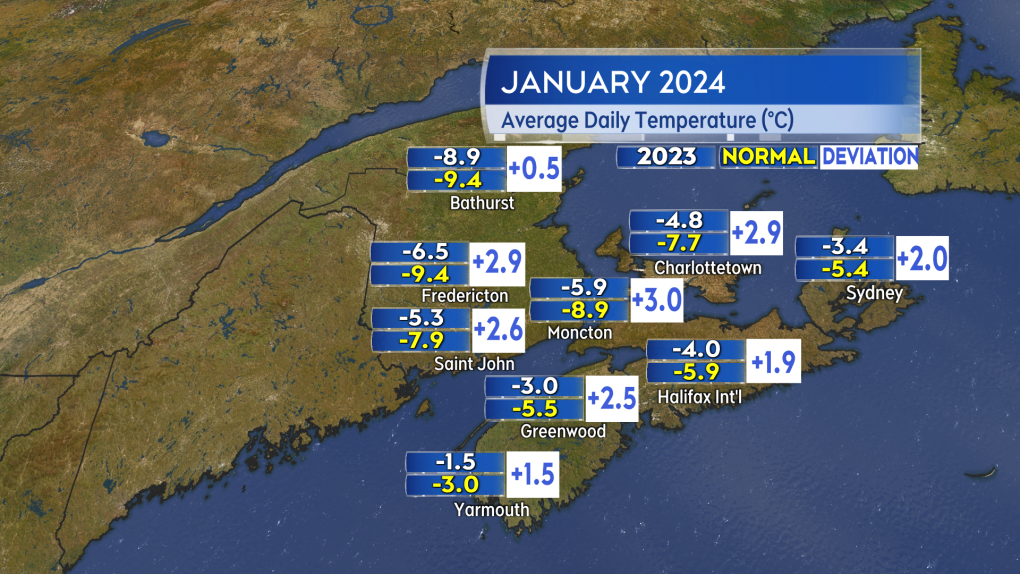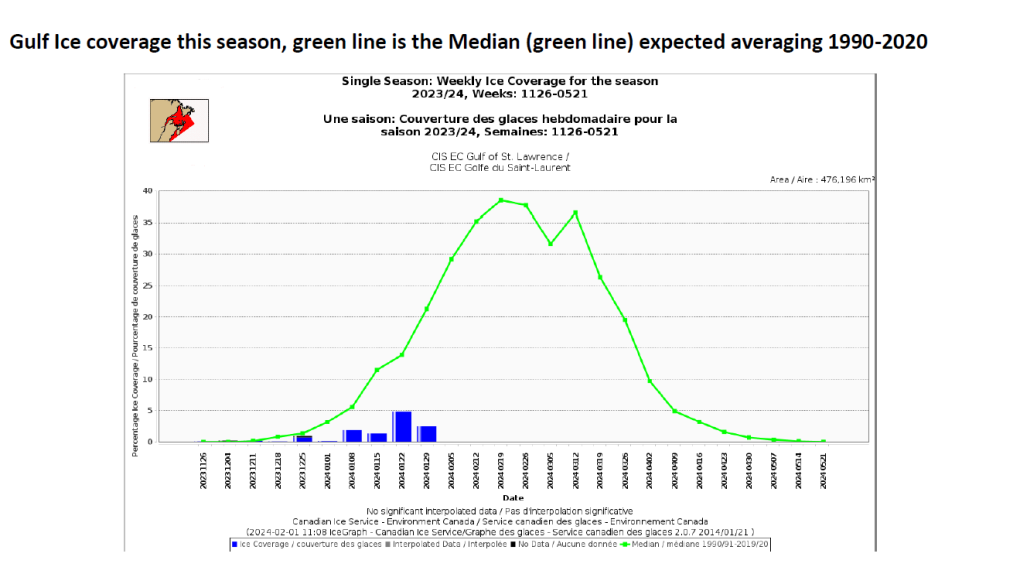Warm January for Maritimes contributes to record lows in sea ice for the Gulf of St. Lawrence
 Sea ice shown on the shorelines of eastern New Brunswick and the North Shore of Nova Scotia in the solid, bright whites. (Courtesy of satellite imagery from NASA).
Sea ice shown on the shorelines of eastern New Brunswick and the North Shore of Nova Scotia in the solid, bright whites. (Courtesy of satellite imagery from NASA).
The month of January finished with above normal temperatures in the Maritimes. While a couple of storm systems moved through the region, they were primarily a mix of snow and rain with each coming with a push of milder in a southerly wind.
 January 2024 average daily temperature compared to 30 year climate normal. (Source: CTV News Atlantic)
January 2024 average daily temperature compared to 30 year climate normal. (Source: CTV News Atlantic)
The combination of storms and warmer air temperatures allowed sea ice in the Gulf of St. Lawrence to reach some daily record lows in the month of January. From notes from Environment Canada and Canadian Ice Services, ice coverage in the Gulf of St. Lawrence briefly reached 4.9 per cent before dropping back to 2.6 per cent. For reference, the average coverage for the month of January is 21.2 per cent.
Ultimately the month ended with the third-lowest ice coverage for the month of January on records going back to 1969.
 Observed sea ice this winter season (blue bars) compared to the climate average (green line). (Courtesy: Environment and Climate Change Canada and Canadian Ice Services).
Observed sea ice this winter season (blue bars) compared to the climate average (green line). (Courtesy: Environment and Climate Change Canada and Canadian Ice Services).
Some of the effects of reduced sea ice include coastal areas that would normally be iced in more susceptible to erosion from wave and wind action. Sea ice coverage can also work to reduce the amount of moisture available for snow squalls for Prince Edward Island and northern/eastern areas of Nova Scotia.
Sea surface temperatures surrounding the Maritimes were also found to be above the January average. Through early February, sea surface temperatures in parts of the Gulf of St. Lawrence are running about a degree above average. Waters off the Atlantic coastline of Nova Scotia are also running about a degree above average. A small area of ocean water in the Gulf of Maine is running slightly below average. The waters of the Bay of Fundy appear to be near average.
High resolution satellite imagery from Feb. 8 doesn’t appear to show much substantial progress in sea ice coverage. There is more present on the shoreline of eastern New Brunswick as well as the North Shore of Nova Scotia. Aside from that, the Gulf of St. Lawrence appears to be largely open and ice cover in the Northumberland Strait looks to be about 50 per cent.
CTVNews.ca Top Stories

Poilievre writes to GG calling for House recall, confidence vote after Singh declares he's ready to bring Liberals down
Conservative Leader Pierre Poilievre has written to Gov. Gen. Mary Simon, imploring her to 'use your authority to inform the prime minister that he must' recall the House of Commons so a non-confidence vote can be held. This move comes in light of NDP Leader Jagmeet Singh publishing a letter stating his caucus 'will vote to bring this government down' sometime in 2025.
BREAKING At least 2 dead and 60 hurt after a car drives into a German Christmas market in a suspected attack
A car plowed into a busy outdoor Christmas market in the eastern German city of Magdeburg on Friday, killing at least two people and injuring at least 60 others in what authorities suspect was an attack.
Judge sentences Quebecer convicted of triple murder who shows 'no remorse'
A Quebecer convicted in a triple murder on Montreal's South Shore has been sentenced to life in prison without chance of parole for 20 years in the second-degree death of Synthia Bussieres.
'I understand there's going to be a short runway,' new minister says after Trudeau shuffles cabinet
Prime Minister Justin Trudeau added eight Liberal MPs to his front bench and reassigned four ministers in a cabinet shuffle in Ottawa on Friday, but as soon as they were sworn-in, they faced questions about the political future of their government, and their leader.
Fake nurse Brigitte Cleroux sentenced for B.C. crimes
A woman who impersonated nurses in several provinces has been sentenced to seven years in prison for offences in British Columbia – where she illegally treated nearly 1,000 patients across multiple communities.
Poilievre to Trump: 'Canada will never be the 51st state'
Conservative leader Pierre Poilievre is responding to U.S. president-elect Donald Trump’s ongoing suggestions that Canada become the 51st state, saying it will 'never happen.'
Toronto officials warn of possible measles exposure at Pearson airport
Toronto Public Health (TPH) is advising of another possible measles exposure at Canada’s largest airport.
Bail denied for Winnipeg woman accused of killing animals in online videos
Warning: This story contains disturbing details. Discretion is advised. A Winnipeg woman accused of making videos of animals being tortured and killed that were sold on the dark web was denied bail.
Party City closing in U.S., Canadian stores remain 'open for business'
The impending closure of all Party City locations in the United States will not extend into Canada.

































